Visiting the National Memorial for Peace & Justice Should Be a Requirement for Every White American

The only thing you're allowed to photograph at the Legacy Museum: From Enslavement to Mass Incarceration in downtown Montgomery, Alabama, is the entrance facade. Immediately above the museum's name, black letters against white, is a photographic triptych of a lynching: a raised wooden scaffold in the center, up whose steps several black men are walking or being pushed, and gathered all around, hundreds of spectators—some are wearing jaunty wide-brimmed hats, someone in the foreground sports an umbrella, several horsemen are taking in the view.
Slavery had been abolished decades before the photograph was taken (the photo looks early 20th century), yet here was a white crowd engaging in racial terrorism and mesmerized by the spectacle of it all.
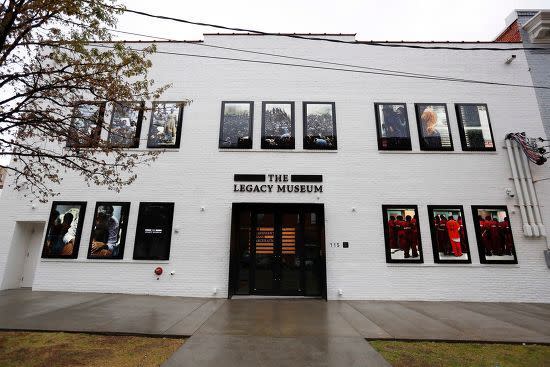
Another photographic triptych, to the right of the museum door, is contemporary. It depicts a group of at least a dozen young African-American men inside a prison. The word "Juvenile" is stamped in large white block letters across the backs of their oversized orange prison jumpsuits, whose pant legs pool heartbreakingly on the floor. Imprisoned children.
Those two photographs encapsulate the message of the Legacy Museum: Slavery may have officially ended in 1865, but the ideology of white supremacy constructed for its moral justification—a narrative of black inferiority, criminality, and danger—endures and finds expression to this day.
This past February I visited both the museum and its companion monument, the Memorial for Peace and Justice, which honors the victims of lynchings. Both closed on March 15 because of the coronavirus pandemic, but are set to reopen later this summer. Which is a good thing.
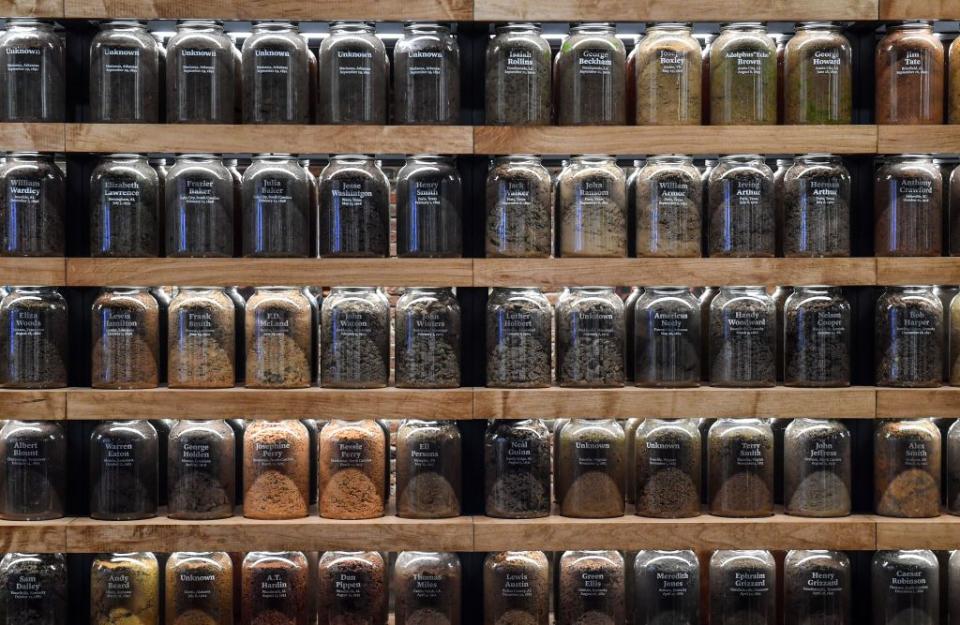
Since their official launch in April 2018, the museum and the memorial have turned sleepy Montgomery into an unlikely tourist mecca: Visitors from across the United States—families; school, church, and community groups; business leaders; government officials; delegations of U.S. senators and congressmen; celebrities—have been descending in droves to either confront the darkest chapters of their country's history or, if they are black, to see finally an affirmation of the truth of their condition.
Now, with the tragic recent killings of George Floyd, Breonna Taylor, and Ahmaud Arbery, and the worldwide uprising against racial injustice and police violence sparked by their deaths, there may be no cultural institutions in this country better suited to the moment.

To console? No: The facts presented in them are nothing if not disturbing, the history of American racism utterly unadorned. To educate? Yes: Here at last, for you to see, is the historical context for some of this country's intractable social and economic ills. To give hope? Well, maybe: Because staring truth in the face, however wrenching, is the only possible way forward.
Both the museum and the memorial are the work of the Equal Justice Initiative (EJI), the non-profit law office and human rights organization founded in 1989 by the widely acclaimed scholar, activist, and public interest lawyer Bryan Stevenson, who 30 years ago, fresh from Harvard Law School, started defending death row prisoners in Alabama.
His best-selling 2014 book, Just Mercy, describes some of his early cases and was made into a feature film of the same title, released last December and starring Michael B. Jordan as Stevenson and Jamie Foxx as one of his clients, Walter McMillian, who had been wrongly sentenced to death for a crime he did not commit. Warner Brothers is making the film free to stream during the month of June on Amazon Prime, You Tube, and Google Play.
Today, EJI continues to provide free legal representation to people who have been illegally convicted, unfairly sentenced, or abused in state prisons. It challenges the death penalty and other forms of excessive punishment, including, importantly, for juveniles, and is broadly dedicated to protecting the basic rights of the most vulnerable people in American society, many of whom are black.
The museum and memorial, funded by $20 million raised from private donations and charitable foundations, are EJI's educational, public-facing arm.
"I took a break [for a while] from my legal career to focus on those cultural institutions," Stevenson said during a recent interview with MSNBC in the aftermath of George Floyd's killing. "The continuing narrative in this country is that black people are not as good as white people. It justifies militarized white power. It is why black communities are targeted and menaced by police. [Today, as a black man,] I still have to navigate the presumption of guilt. The protests? They're about the accumulation of exhaustion, of fatigue. People are tired. None of us thought that 50 years after the civil rights movement black people would still be marginalized. How resistant our nation is to change. I wanted [with these institutions] to affect people's behavior."
Come to Montgomery and you will be affected. Step into the hallway that leads from the lobby of the Legacy Museum to its exhibition space and you enter a dark, downward sloping tunnel. Along its walls are replicas of slave pens. Montgomery, the first capital of the Confederacy, was also, between 1850 and the end of the Civil War, a hub of the immense domestic slave trade, and the museum stands on the site of a warehouse where people were held before being auctioned off.
Onto the back walls of the pens are projected life-size holograms of black Americans in 19th-century garb—three men in one pen; a single woman in another; two young children in what look like white nightshirts, alone. Ghostly presences, they stand there, looking at you. Voice recordings on a loop read out in quiet tones from real first-person accounts of enslaved people describing what it was like to be imprisoned awaiting sale. "Mama?!" you hear one of the children call out, uncomprehendingly, into the darkness. And the other, slightly older, as if trying to be brave, calmly asks, "Have you seen our mother?"
A sign near the entrance to the museum quotes an enslaved man named Aaron. "Go to the slave auction!" he exhorts. "See human souls bartered for flesh. See families... separated, never more to meet in this world.... Follow out the investigation into [slavery's] detail, and you will begin to learn the greatness of the sin."
Beyond the tunnel lie some 11,000 square feet of exhibition space. It is not a large museum, but it is richly layered. The entire EJI team spent more than a decade meticulously researching and gathering historical documents, rarely-seen first-person accounts, and photographs. They are all assembled here into displays both high tech and low, contemplative and interactive.
Presented with precise lawyerly accumulation of detail and also a lawyer's knack for the emotional gesture, they irrefutably drive home how slavery did not end after the Civil War because the ideology of white supremacy continued to manifest itself in terror lynchings, convict leasing, legalized racial segregation under Jim Crow, opposition to civil rights for black Americans, voter suppression, mass incarceration, and the culture of police violence.
Spend even a few hours here (you could spend days) and you comprehend, if you didn't before, "the greatness of the sin."
At the Memorial for Peace and Justice there is no accretion of details—other than the names of the murdered, which exert a power similar to those on Maya Lin's Vietnam Memorial in Washington, D.C.
The memorial was conceived as a single installation laid out on a six-acre grassy hill overlooking downtown Montgomery and the State Capitol building that once housed the Confederacy. It is meant to be walked through and contemplated rather than studied.
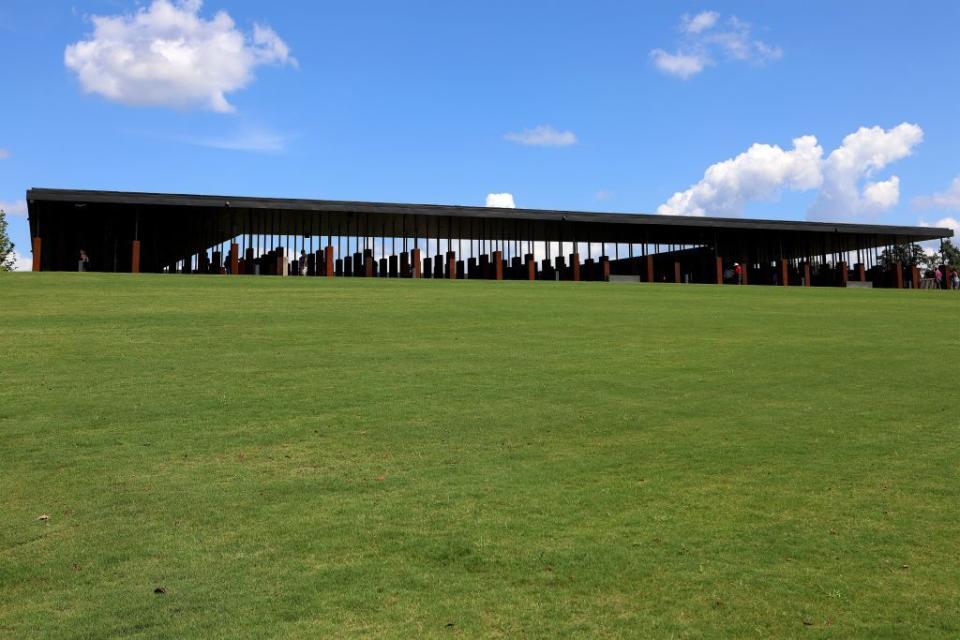
Stevenson has said that he was inspired to create it by Germany's Holocaust Memorial and parts of South Africa's Apartheid Museum. It is telling that until this site, the United States—unlike, say, Rwanda, with its Genocide Memorial—has had no monument commemorating its greatest atrocity: the systematic hanging, burning, and otherwise torturing to death by whites of 4,075 African-American men, women, and children.
(The number represents the deaths that the EJI team was able conclusively to document by doggedly digging through court records and county newspapers; it is 800 more murders, according to the New York Times, than scholars had previously counted.)
Inside the open-sided central pavilion, which you reach via an upward sloping gravel path past several large sculptures, stand or hang 816 six-foot-tall reddish, rusted, rectangular steel slabs, stelae-like, each inscribed with the name of a county and a state where lynchings occurred, followed by the names of the lynched and the dates of their deaths.
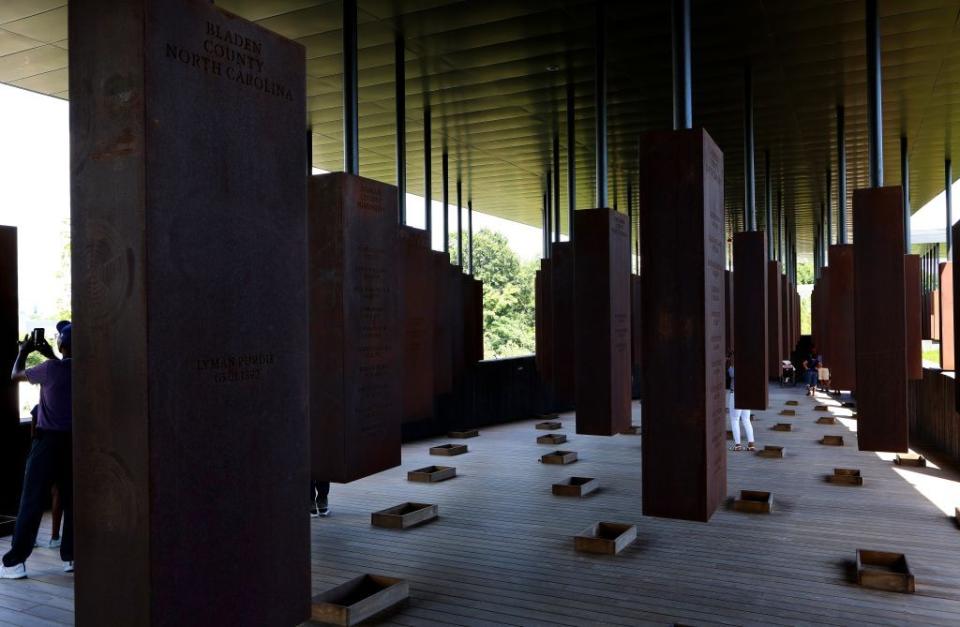
You advance slowly among them, wanting to do each name justice. To pause for a moment, to try to commit it to memory.
Calhoun County, Georgia: Emma Mike,12/01/1884; Lillie Mike, 12/01/1884;
Unknown, 12/01/1884.
What happened there on that one day?
Florence County, South Carolina: Cairo Williams, 06/30/1904; William McCallister, 01/014/1922.
Some stelae have a dozen names on them; others just a few. As you walk deeper into the steel forest, turn a corner, the floor of the pavilion begins to slope down, giving the slabs, which are all attached to the roof of the pavilion via metal rods, the appearance of rising. Soon, the floor has descended so low, the slabs are so far above you, that you can't even make out the names any more, and walk beneath them like one of those indifferent spectators at a public lynching. The scale of the killing is harrowing.
Along one wall of the pavilion, brief summaries of the circumstances of the circumstances of some of the killings suddenly appear:
"Fred Rochelle, 16, was burned alive in a public spectacle lynching before thousands in Polk County, Florida, in 1901."
"David Walker, his wife, and their four children were lynched in Hickman, Kentucky, in 1908 after Mr. Walker was accused of using inappropriate language with a white woman."
"Seven black people were lynched near Screamer, Alabama, in 1888, for drinking from a white man's well."
"Caleb Gadley was lynched in Bowling Green, Kentucky, in 1894, for walking behind the wife of his white employer."
"Henry Smith, 17, was lynched in Paris, Texas, in 1893, before a mob of 10,000 people."
At the far end of the pavilion stands a long dark wall down which water softly and continuously cascades. It is otherwise blank except for this inscription: "Thousands of African Americans are unknown victims of racial terror lynchings whose deaths cannot be documented, many whose names will never be known. They are all honored here."
Stevenson often remarks that unlike other countries with divisive histories (Germany, South Africa, Rwanda) who've had their difficult moments of "truth and reconciliation," we in the United States "have not reckoned with the history of our country." The stark, powerful exhibits at the museum and the memorial in Montgomery are our chance to begin.
But the question will still remain: What are we going to do about it, "the greatness of the sin"?
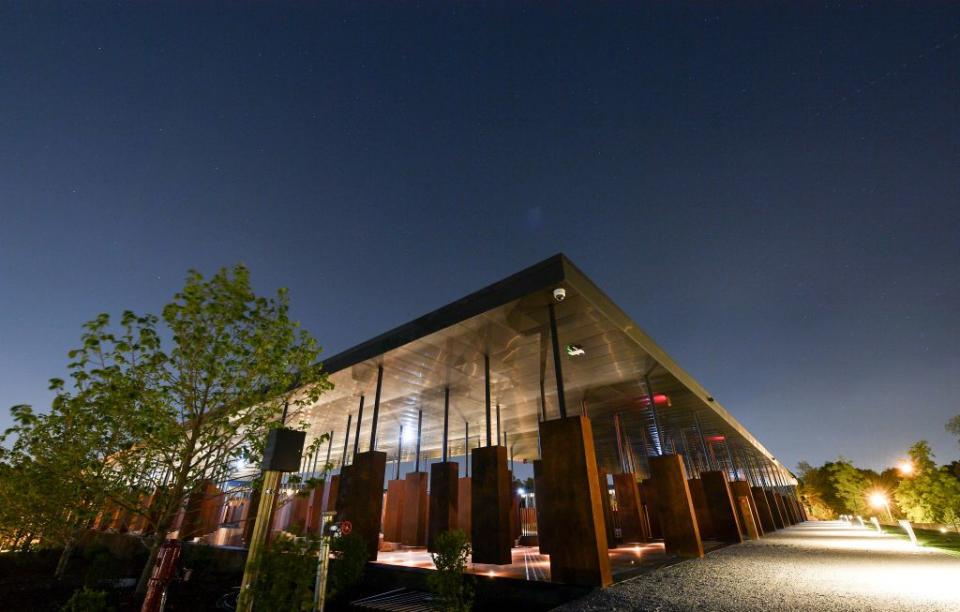
Planning a Trip
The Legacy Pavilion, a new addition to the museum and memorial complex, is its welcome center. It includes free parking, the ticket office, a gift and book shop, a cafe and restaurant, and additional exhibition spaces, as well as a monument memorializing more than 2,000 black men, women, and children who were lynched between 1865 and 1876. EJI buses shuttle visitors at regular intervals between the Pavilion and the other sites if needed. The entrance to the Legacy Museum is on downtown's Coosa Street, a few blocks from where Rosa Parks got on that bus. The Memorial for Peace and Justice is a 16-minute walk away, as is the Peace and Justice Memorial Center, across the street from it. The latter includes an auditorium where EJI staff offer presentations to visitors at 2:30 p.m. on Mondays, Thursdays, Fridays, and Saturdays (they are excellent and well worth it). At the Center's entrance, yet another monument commemorates 24 black men and women who were killed in racially motivated attacks in the 1950s.
You Might Also Like

